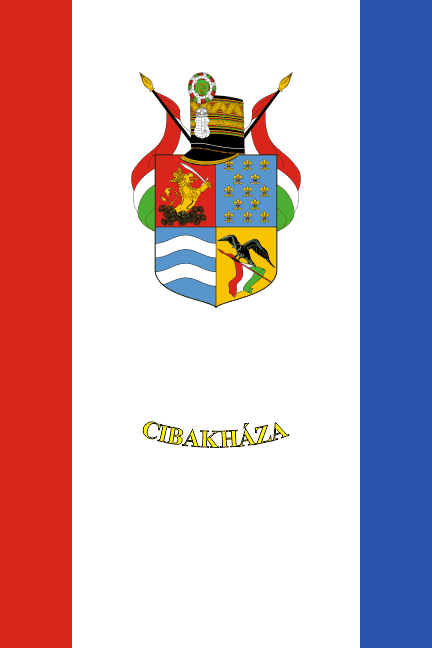 (2:3)
(2:3) image by Zoltan Horvath, 26 January 2025

Last modified: 2025-02-07 by zoltán horváth
Keywords: hungary | jasz-nagykun-szolnok | cibakhaza | lion | diadem | sword.lily | turul | atilla |
Links: FOTW homepage |
search |
disclaimer and copyright |
write us |
mirrors
 (2:3)
(2:3)
image by Zoltan Horvath, 26 January 2025
See also:
Cibakháza is a large village in Jász-Nagykun-Szolnok County in
Hungary on the Great Hungarian Plain on the left bank of the
Tisza River near to Szolnok City (30 km South). The settlement
has got 4.446 inhabitants (1990 census), nearly all of them are
Hungarians. One of the Official Ethnic Minorities of Hungary has
got ethnic council in the settlement: the Gipsy. Neighbouring
settlements are: Vezseny, Tiszajenő, Nagyrév villages,
Kunszentmárton and Tiszaföldvár towns..
The first mention of the settlement is from 1465. In 1500 the
settlement was a borough. Landlords were the Kenechki and Czibak
(!) families. Till 1552 Cibakháza was in the Outer-Szolnok
County of the Kingdom of Hungary. 1552-1685 it was under Turkish
rule (part of the Buda Vilayet). In 1660 Cibakháza was an
important ferry. 1685-1876 it was in the Heves-Outer-Szolnok
County. In 1848-49 there was an important battle of the War of
Independence. In 1910 Cibakháza was a village in the Lower Tisza
district of Jász-Nagykun-Szolnok County of the Kingdom of
Hungary. Number of its inhabitants in 1910: 5.252; 5.218 (99,4%)
Hungarian and 34 (0,6%) other by mother tongue, 4.743 (90,3%)
Roman Catholic, 389 (7,4%) Calvinist, 61 (1,2%) Lutheran and 59
(1,1%) other by religion.
István Molnár, 11 March 2001
The flag of municipality is white with a red and a blue horizontal stripe and its coat of arms placed in the center of the white stripe. The width of red and blue stripes is one-sixth of width of hoist site of the flag. Ratio is 2:3.
The flag was adopted on 20 August 1996. I haven't found the legislation on line.
The original flag can be seen at 32:10 in this video:
https://cibakhaza.hu/foto-es-videotar/unnepi-testuleti-ules/
Later, the name of the settlement was added to the flag, and placed it under the coat of arms in arc with yellow letters:
Image of flag:
https://sokszinuvidek.24.hu/viragzo-videkunk/2022/07/12/cibakhaza-homokpad-sziget-elcsatolas-fennhatosag/
Zoltan Horvath, 26 January 2025

image by Zoltan Horvath, 26 January 2025

image by Zoltan Horvath, 26 January 2025
The vertical flag has the same element,s but coat of arms is turned upwards and placed in upper one-third of the flag,
while name of the settlement is placed in the lower one-third of the flag.
Zoltan Horvath, 26 January 2025
jn-ci.gif)
image by Zoltan Horvath, 26 January 2025
Information from the Homepage at <www.cibakhaza.szolnex.hu>.
Description about the Coat of Arms and the
flag (in Hungarian) at <www.cibakhaza.szolnex.hu/cimer.htm>:
Description of the Coat of Arms: Standing shield with pointed
bottom divided into four parts. In the right upper red field
there is an armed gold lion turning left with two tails. On its
head there is a five pointed gold diadem. The lion puts forward
its right hand and in its left hand there is a silver sword with
gold hilt. This symbol relates to the Cybak Family (which came
from Italy in the 14th century) who's name the settlement got. In
the left blue field there are thirteen gold lilies. This symbol
relates to the great victory of the Hungarian Army in 1849 in
Cibakháza and relates to the Thirteen Martyr Of Arad - the 13
general who was executed after the surrendering of the Independence
War. On the right bottom blue field there is two wavy silver
stripes relate to the Tisza and the Körös rivers. On the left
bottom gold field there is a flying black TURUL (Austur v. Falco
sacer). On its talons there is a national - red-white-green -
flag. The Turul was the symbol of Atilla, King of the Huns. This
symbol relates to the Hungarians' heroic standing their ground
from the Conquest to nowadays, at the time of the Turkish Wars,
in 1848-49 and in the World Wars. On the shield there is a black
Home Guard shako from 1848-49 with gold strings and silver coat of arms.
Both on the left and right sides there are a national flag.
István Molnár, 11 March 2001